ZHCSF64B June 2016 – January 2018 ADS8910B , ADS8912B , ADS8914B
PRODUCTION DATA.
- 1 特性
- 2 应用
- 3 说明
- 4 Revision History
- 5 Pin Configuration and Functions
- 6 Specifications
-
7 Detailed Description
- 7.1 Overview
- 7.2 Functional Block Diagram
- 7.3 Feature Description
- 7.4 Device Functional Modes
- 7.5
Programming
- 7.5.1 Output Data Word
- 7.5.2 Data Transfer Frame
- 7.5.3 Interleaving Conversion Cycles and Data Transfer Frames
- 7.5.4 Data Transfer Protocols
- 7.5.5 Device Setup
- 7.6
Register Maps
- 7.6.1
Device Configuration and Register Maps
- 7.6.1.1 PD_CNTL Register (address = 04h) [reset = 00h]
- 7.6.1.2 SDI_CNTL Register (address = 008h) [reset = 00h]
- 7.6.1.3 SDO_CNTL Register (address = 0Ch) [reset = 00h]
- 7.6.1.4 DATA_CNTL Register (address = 010h) [reset = 00h]
- 7.6.1.5 PATN_LSB Register (address = 014h) [reset = 00h]
- 7.6.1.6 PATN_MID Register (address = 015h) [reset = 00h]
- 7.6.1.7 PATN_MSB Register (address = 016h) [reset = 00h]
- 7.6.1.8 OFST_CAL Register (address = 020h) [reset = 00h]
- 7.6.1.9 REF_MRG Register (address = 030h) [reset = 00h]
- 7.6.1
Device Configuration and Register Maps
-
8 Application and Implementation
- 8.1 Application Information
- 8.2 Typical Application
- 9 Power-Supply Recommendations
- 10Layout
- 11器件和文档支持
- 12机械、封装和可订购信息
6.7 Switching Characteristics
At RVDD = 5.5 V, DVDD = 1.65 V to 5.5 V, VREF = 5 V, and maximum throughput (unless otherwise noted).Minimum and maximum values at TA = –40°C to +125°C; typical values at TA = 25°C.
| PARAMETER | MIN | TYP | MAX | UNIT | TIMING DIAGRAM | ||
|---|---|---|---|---|---|---|---|
| CONVERSION CYCLE | |||||||
| tconv | Conversion time | ADS8910B | 580 | 640 | ns | Figure 1 | |
| ADS8912B | 1100 | 1200 | |||||
| ADS8914B | 2400 | 2500 | |||||
| ASYNCHRONOUS RESET, AND LOW POWER MODES | |||||||
| td_rst | Delay time: RST rising to RVS rising | 3 | ms | Figure 2 | |||
| tPU_ADC | Power-up time for converter module | 1 | ms | See PD_CNTL Register | |||
| tPU_REFBUF | Power-up time for internal reference buffer, CREFBUF = 22 µF | 10 | ms | ||||
| tPU_Device | Power-up time for device | CLDO = 1 µF, CREFBUF = 22 µF | 10 | ms | |||
| SPI-COMPATIBLE SERIAL INTERFACE | |||||||
| tden_CSDO | Delay time: CS falling to data enable | 9 | ns | Figure 3 | |||
| tdz_CSDO | Delay time: CS rising to SDO going to Hi-Z | 10 | ns | ||||
| td_CKDO | Delay time: SCLK launch edge to (next) data valid on SDO | 13 | ns | ||||
| td_CSRDY_f | Delay time: CS falling to RVS falling | 12 | ns | Figure 4 | |||
| td_CSRDY_r | Delay time: CS rising to RVS rising |
After NOP operation | 30 | ns | Figure 4 | ||
| After WR or RD operation | 120 | ||||||
| SOURCE-SYNCHRONOUS SERIAL INTERFACE (External Clock)(1) | |||||||
| td_CKSTR_r | Delay time: SCLK launch edge to RVS rising | 13 | ns | Figure 4 | |||
| td_CKSTR_f | Delay time: SCLK launch edge to RVS falling | 13 | ns | ||||
| toff_STRDO_f | Time offset: RVS falling to (next) data valid on SDO | -2 | 2 | ns | |||
| toff_STRDO_r | Time offset: RVS rising to (next) data valid on SDO | -2 | 2 | ns | |||
| tph_STR | Strobe output high time, 2.35 V ≤ DVDD ≤ 5.5 V | 0.45 | 0.55 | tSTR | |||
| tpl_STR | Strobe output low time, 2.35 V ≤ DVDD ≤ 5.5 V | 0.45 | 0.55 | tSTR | |||
| SOURCE-SYNCHRONOUS SERIAL INTERFACE (Internal Clock) | |||||||
| td_CSSTR | Delay time: CS falling to RVS rising | 15 | 50 | ns | Figure 5 | ||
| tSTR | Strobe output time period | INTCLK option | 15 | ns | |||
| INTCLK / 2 option | 30 | ||||||
| INTCLK / 4 option | 60 | ||||||
| tph_STR | Strobe output high time | 0.45 | 0.55 | tSTR | |||
| tpl_STR | Strobe output low time | 0.45 | 0.55 | tSTR | |||
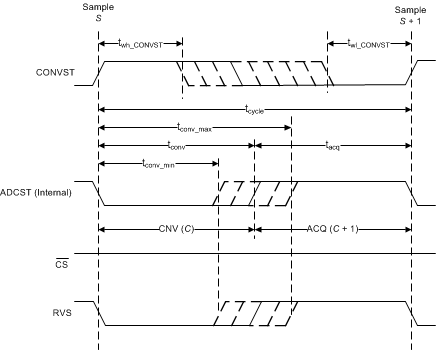 Figure 1. Conversion Cycle Timing
Figure 1. Conversion Cycle Timing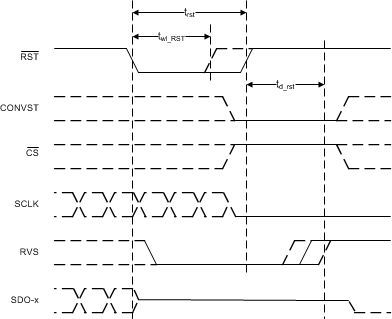 Figure 2. Asynchronous Reset Timing
Figure 2. Asynchronous Reset Timing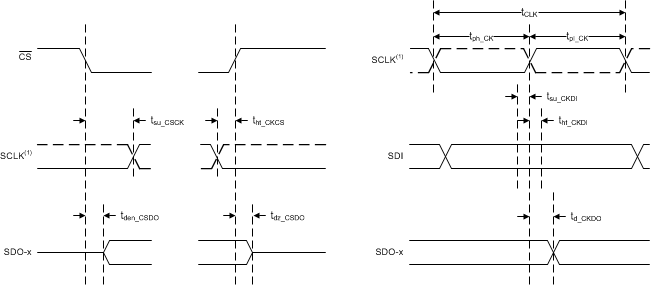
1. The SCLK polarity, launch edge, and capture edge depend on the SPI protocol selected.
Figure 3. SPI-Compatible Serial Interface Timing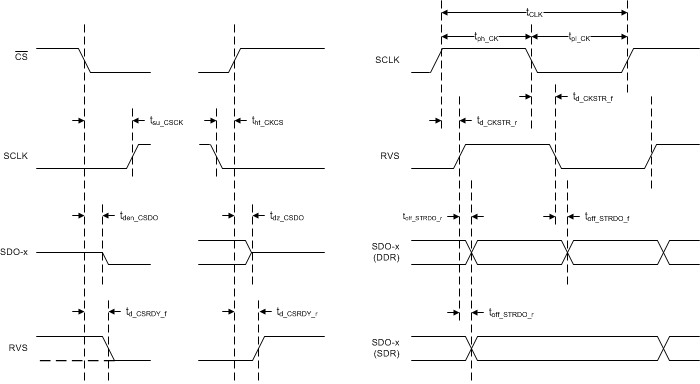 Figure 4. Source-Synchronous Serial Interface Timing (External Clock)
Figure 4. Source-Synchronous Serial Interface Timing (External Clock)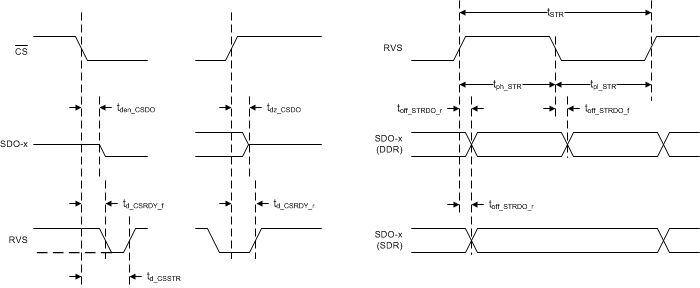 Figure 5. Source-Synchronous Serial Interface Timing (Internal Clock)
Figure 5. Source-Synchronous Serial Interface Timing (Internal Clock)